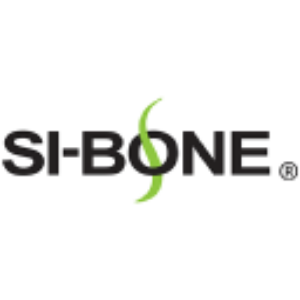SI-BONE, Inc. Announces that Updated ISASS Policy and Guidelines on MIS SI Joint Fusion Support Only Lateral Transiliac MIS Procedures
SANTA CLARA, Calif., Jan. 04, 2021 (GLOBE NEWSWIRE) -- SI-BONE, Inc. (SIBN) announced that the International Society for the Advancement of Spine Surgery published its updated Policy on MIS Sacroiliac Joint Fusion. The policy supports the adoption of MIS SI joint fusion procedures, particularly the iFuse Procedure, based on high-level clinical evidence for its safety and effectiveness. The ISASS does not recommend MIS posterior SI joint fusion due to inadequate clinical evidence. This update provides crucial guidance for clinicians and payors regarding the iFuse Implant System.
- ISASS policy supports continued adoption of MIS SI joint fusion procedures.
- High-level clinical evidence favors the iFuse Procedure for safety and effectiveness.
- Updated policy provides a roadmap for payors and clinicians regarding iFuse.
- ISASS does not endorse posterior MIS SI joint fusion due to limited evidence.
Insights
Analyzing...
SANTA CLARA, Calif., Jan. 04, 2021 (GLOBE NEWSWIRE) -- SI-BONE, Inc., (Nasdaq: SIBN), a Silicon Valley-based medical device company dedicated to solving musculoskeletal disorders of the sacropelvic anatomy, announced today that the International Society for the Advancement of Spine Surgery (ISASS) published an early view of its updated Policy on MIS Sacroiliac Joint Fusion (For Chronic Sacroiliac Joint Pain) in the December 2020 issue of the International Journal of Spine Surgery (https://www.ijssurgery.com). The policy and guidelines remain supportive of continued adoption of MIS SI joint fusion procedures by the clinician and payor communities, limited to procedures using a lateral transiliac approach, which includes the iFuse Procedure™. While the ISASS policy does not endorse any specific MIS SIJ system, the updated policy states that “…most high-level clinical evidence supporting the safety, effectiveness, durability and economic benefit of lateral MIS SIJF is derived from use of iFuse.”
ISASS does not recommend MIS posterior (dorsal) SI joint fusion procedures, whether using an implantable device or a product such as bone allograft. This is due to the limited published clinical evidence supporting the safety and effectiveness of posterior (dorsal) SI joint fusion, as well as the key differences from lateral transiliac procedures such as the iFuse Procedure in terms of surgical steps, work effort and anatomy considerations. The ISASS policy states that the high-level clinical and safety data from evaluation of MIS lateral transiliac SI joint fusion devices such as iFuse “are likely not generalizable to these posterior (dorsal) MIS SIJF procedures.”
W. Carlton Reckling, M.D., Chief Medical Officer and Vice President of Medical Affairs at SI-BONE, said “the updated ISASS policy and clinical guidelines provide important updates on the clinical evidence and the current medical practice including MIS SI joint fusion treatment options, which have evolved significantly over the past several years. The ISASS policy provides a roadmap and rationale for clinicians, payors and other third-party evaluators for their adoption of the iFuse Implant System.”
About SI-BONE
SI-BONE is a medical device company that pioneered the iFuse Implant System, a minimally invasive surgical system for fusion of the sacroiliac joint to treat sacroiliac joint dysfunction. The SI joint is believed to be the last major joint with a clinically proven surgical treatment. The iFuse Implant™, commercially available since 2009, is believed to be the only SI joint fusion device supported by multiple prospective clinical studies showing improved pain, patient function and quality of life resulting from treatment. There are over 90 peer-reviewed publications supporting the safety, effectiveness, and biomechanical and economic benefits unique to the iFuse Implant (www.si-bone.com/results). This body of evidence has enabled multiple government and private insurance payors to establish coverage of the SI joint fusion procedure exclusively when performed with the iFuse Implant System.
The iFuse Implant System is intended for sacroiliac fusion for conditions including sacroiliac joint dysfunction that is a direct result of sacroiliac joint disruption and degenerative sacroiliitis. This includes conditions whose symptoms began during pregnancy or in the peripartum period and have persisted postpartum for more than 6 months. The iFuse Implant System is also intended for sacroiliac fusion to augment stabilization and immobilization of the sacroiliac joint in skeletally mature patients undergoing sacropelvic fixation as part of a lumbar or thoracolumbar fusion. In addition, the iFuse Implant System is intended for sacroiliac fusion in acute, non-acute, and non-traumatic fractures involving the sacroiliac joint. There are potential risks associated with the iFuse Implant System. It may not be appropriate for all patients and all patients may not benefit.
SI-BONE and iFuse Implant System are registered trademarks of SI-BONE, Inc. ©2021 SI-BONE, Inc. All Rights Reserved. 01042021
Media Contact:
Joe Powers
jpowers@si-bone.com
669-206-2521
Investor Contacts:
Matt Bacso, CFA
investors@SI-BONE.com







